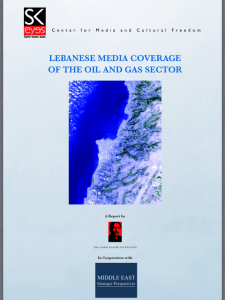SKeyes and Middle East Strategic Perspectives monitored media coverage of the Lebanese oil and gas sector. It was decided early on that coverage of the petroleum sectors in Cyprus and Israel would also be included in the analysis. The monitoring period extended from February 1 to April 15, 2014. Six TV channels, five daily newspapers, two news websites and one magazine were subjected to an in-depth qualitative and quantitative monitoring.
|
TV Channels |
Newspapers |
News Websites |
Magazines |
| LBC | Annahar | NOW English | Executive Magazine |
| MTV | Assafir | El-Nashra | |
| Al-Jadeed | Al-Akhbar | ||
| OTV | The Daily Star | ||
| Future TV | L’Orient-Le Jour | ||
| Al-Manar |
- Frequency of reporting on the topic over the monitored time period;
- Accuracy of information;
- Reliability of sources;
- Topics covered; and
- Quality of investigations
Major Trends
1. The media had a clear preference for political news coverage and analysis, at the expense of other types of coverage (technical, investigative,
educational/informative, etc.)
2. News coverage (whether covering political or non-political issues) amounted to nearly half of all stories (57 out of 122), possibly indicating a difficulty in producing other, more insightful, types of material.
3. Although a journalist is prone to commit fewer mistakes when simply covering the news, the number of errors in stories categorized as “news coverage” is still relatively high (21 errors in 57 stories). These mistakes were not only committed by authors but also by many of the sources the authors quoted in their stories.
4. Given the importance of opinion pieces in providing prescriptive analysis, the number of errors made in this type of coverage can also be perceived as relatively high (11 errors in 28 articles). However, it should be noted that all these errors were made in seven pieces (the other 21 did not contain any factual mistakes).
5. Few articles tackled social activism (environment 2; civil society 1) possibly reflecting limited civil society involvement at this stage.
6. Lebanese media showed a very limited interest in covering oil and gas developments in neighboring countries (five stories, out of 122, including three brief TV reports aired during the evening news). The type of errors made when covering developments in neighboring countries reflects a poor grasp of the subject.
7. The most common mistakes repeated by journalists involved the use of inaccurate terminology and reference to inaccurate estimates of the country’s potential resource wealth.
8. In addition, some basic information and official data are often inaccurate: the number of offshore blocks; companies shortlisted for the first licensing round; the percentage of offshore area covered by 3D surveys; etc. The fact that such information could be easily acquired or verified might indicate that not enough effort is being put into fact-checking oil and gas stories.
9. On average, there was just above one source per story. Some media outlets seemed keener on quoting sources than others, but this did not always ensure quality. In fact, many of the mistakes made are attributed to sources (not to the author of the story).
[button link=”https://mesp.me/wp-content/uploads/2014/08/Lebanese-Media-Coverage-of-the-Oil-and-Gas-Sector.pdf” style=”download” color=”silver” text=”dark”]Full Report & Recommendations[/button]

